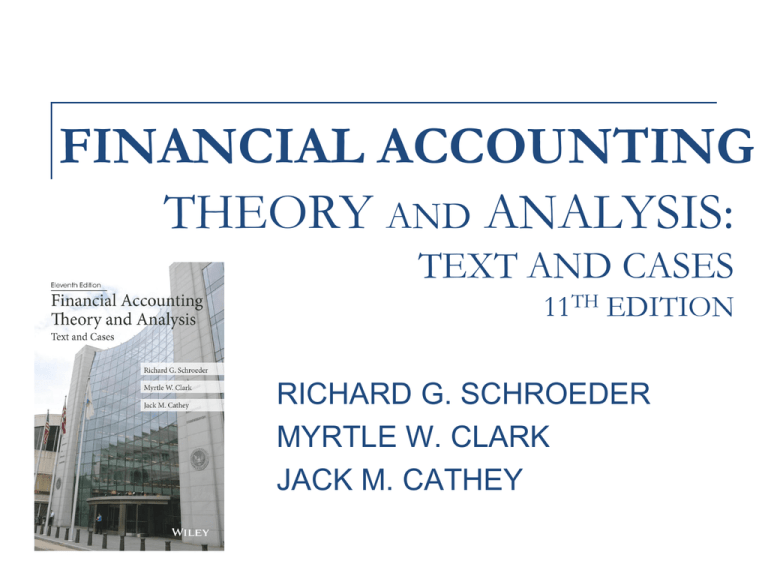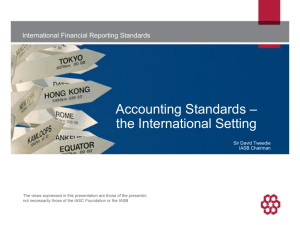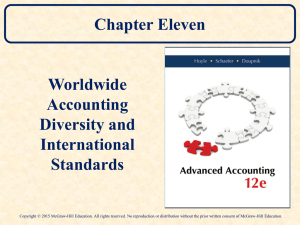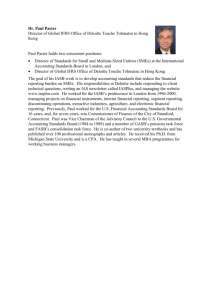
FINANCIAL ACCOUNTING
THEORY AND ANALYSIS:
TEXT AND CASES
11TH EDITION
RICHARD G. SCHROEDER
MYRTLE W. CLARK
JACK M. CATHEY
CHAPTER 3
INTERNATIONAL ACCOUNTING
International Accounting
Standards
Financial accounting is influenced
by the environment in which it operates
Companies develop financial reports directed at their
primary users
Previously most were residents of the same country as the
corporation
Transnational financial reporting has become more commonplace
because of the European Union, GATT and NAFTA
U. S. companies must be able to compete in global
markets with transnational financial reporting
International Business Accounting
Issues
A company’s first exposure to
international accounting is
frequently the result of a purchase
or sale
Problems:
1 Exchange gains or losses
2 Obtaining credit information
3 Evaluation of financial statements
Next step may be to open an international division
Another issue is raising capital in foreign markets
Must prepare financial statements in a format acceptable
by appropriate securities market
Factors Influencing the Development
of Accounting Systems:
Level of
Education
Legal
System
Political
System
Economic
Development
Influences on the Development of
Financial Reporting
Type of
economy
Agricultural
Resource Based
Tourist Based
Manufacturing
Legal
System
Codified
Common Law
Political
System
Democratic
Totalitarian
Nature of
Ownership
Private Enterprise
Socialist
Communist
Influences on the Development of
Financial Reporting
Growth
Pattern of
economy
Growing
Stable
Declining
Social Climate
Stability of currency
Sophistication of management
Sophistication of financial community
Existence of accounting legislation
Education System
Approaches to Preparing Financial
Statements for Use in Other
Countries:
1
2
3
4
5
Same to all
Translate language
Translate language and currency
Two sets
World-wide standards
The International Accounting
Standards Committee
The preparation of financial statements for foreign users
under option #5 is being increasingly advocated
IASC
Formed in 1973 to
aid in this process
International
Accounting
Standards Board
Replaced IASC in
2001
Standard Setting by the IASC
Original intent:
Avoid complex details
Concentrate on basic standards
Steps in the process
Similar to FASB
1 Steering Committee
2 Identify issues and prepare point outline
3 Board prepares comments
4 Steering Committee prepares final Statement of Principles
5 Exposure Draft
6 Steering Committee reviews comments and prepares final standard
Standard Setting by the IASC
Two treatments
1 Benchmark - point of reference
2 Alternative
Improvements Project
2003
Removed some of the existing alternative accounting
treatments
Where an IAS retains alternative treatments
IASB removed references to 'benchmark treatment'
Now termed 'alternative treatment'
Using descriptive references
‘Cost model'
‘Revaluation model'
Restructuring the IASC
In its early years, IASC acted mainly as a harmonizer
Recently, it has begun to combine that role with the role of a
catalyst
Harmonizer
Catalyst
Coordinator of national initiatives
Initiator of new work
at national level
Restructuring the IASB
Future IASB role as catalyst and initiator should become
more prominent
Important for the IASB to focus objectives more precisely,
as follows:
1. To develop international accounting standards that require highquality, transparent, and comparable information that will help
participants in capital markets and others to make economic
decisions; and
2. To promote the use of international accounting standards by
working with national standard setters.
Restructuring the IASB
Structural changes needed
So that IASB can anticipate the new challenges facing it and meet those
challenges effectively.
Issues that need to be addressed:
1. Partnership with national standard setters.
IASB should enter into a partnership with national standard setters
So that IASB can work together with them to accelerate
Convergence between national standards
And international accounting standards around solutions requiring highquality, transparent, and comparable information
That will help participants in capital markets and others to make
economic decisions.
Restructuring the IASB
2.
Wider participation in the IASB Board.
A wider group of countries and organizations should take part in the
IASB Board
3.
Without diluting the quality of the Board's work
Appointment.
The process for appointments to the IASB Board and key IASB
committees should be the responsibility of a variety of
constituencies
Those appointed must be competent , independent, and objective.
Restructuring the IASB
2001:
Responsibility for international standardssetting was transferred to the to the
International Accounting Standards
Board (IASB)
Restructuring the IASB
The new structure:
The IASC Foundation
The International Accounting
Standards Board
The International Accounting
Standards Advisory Council
International Financial Reporting
Interpretations Committee
IASB Structure
Appoints
KEY:
Reports To
Advises
Monitoring Board
Approve and Oversee Trustees
IASC Foundation
22 Trustees Appoint, Oversee, Raise Funds
Board: 16 (Maximum 3 part-time)
Set Technical Agenda. Approve Standards,
Exposure Drafts, & Interpretations
IFRS Advisory
Council
Approx. 40 members
Working Groups
For Major Agenda Projects
IFRS Interpretations
Committee
(14 members)
Revising the IASB’s Constitution
Key issues to be reviewed:
1. Whether the objectives of the IASC Foundation should
expressly refer to the challenges facing small and mediumsized entities (SMEs)
2. Number of Trustees and their geographical and professional
distribution
3. The oversight role of the Trustees
4. Funding of the IASC Foundation
5. The composition of the IASB
6. The appropriateness of the IASB's existing formal liaison
relationships
7. Consultative arrangements of the IASB
8. Voting procedures of the IASB
9. Resources and effectiveness of the International Financial
Reporting Interpretations Committee (UMC):
10. The composition, role, and effectiveness of the SAC
The Uses of International
Accounting Standards
IASC noted that its standards are used in a variety of
ways:
1 National requirements
2 Basis for national requirements
3 Benchmark to develop standards
4 By regulatory agencies
5 By companies
Also International Organization of Securities Commissions
(IOSCO) looks to the IASC to provide standards that can
be used in multinational securities offerings
Other Issues
Partnership with the IOSCO
Generate standards acceptable to IOSCO
December 17, 2003
IASB published 13 revised International Accounting Standards
Reissued two others
Gave notice of the withdrawal of its standard on price level
accounting.
Revised and reissued standards mark near-completion of
the IASBs Improvements project
2005: reaffirmed support and development of IFRS
IASB Annual Improvements Project
July 2006
Non-urgent issues
Amendments
The Use of IASC Standards
Adopted by approx. 120 countries
EU
Australia
New Zealand
Planned option by others
Israel
Canada
Japan
China
US (?)
FASB Short-term International
Convergence Project
The goal of this project is to remove a variety of
individual differences between U.S. GAAP and
International Financial Reporting Standards that are not
within the scope of other major projects.
The project scope is limited to those differences in which convergence
around a high-quality solution would appear to be achievable in the
short-term, usually by selecting between existing IFRS and U.S. GAAP.
The Norwalk Agreement
12/18/2002:
FASB and IASB held joint meeting in Norwalk, Connecticut
Both standard setting bodies acknowledged…
Their commitment to the development of high-quality compatible
accounting standards that can be used for both domestic and
cross-border financial reporting.
Also committed to use their best efforts to make their existing
financial reporting standards compatible as soon as
practicable and to coordinate their future work programs to
help ensure that once compatibility is achieved, it will be
maintained.
The Norwalk Agreement
Both Boards agreed to:
1. Undertake a short-term project aimed at removing a variety of
differences between U. S. GAAP and IFRSs.
2. Remove any other differences between IFRSs and U. S.
GAAP that may remain on January 1, 2005 by undertaking
projects that both Boards would address concurrently.
3. Continue the progress on the joint projects currently underway.
4. Encourage their respective interpretative bodies to coordinate
their activities.
The Roadmap to Convergence
2005 agreement between FASB & IASB:
Convergence best achieved with high-quality, common
standards
Develop a new common standard rather than try to eliminate
differences
Replace weaker standards with stronger standards
The Roadmap to Convergence
7 Original Milestones
1.
2.
3.
4.
5.
6.
7.
Improvements to accounting standards
Funding of IASCF
Improved ability to use interactive data for IFRS reporting
Improved education and training in the US
Limited use in narrow group of companies
SEC to determine in 2011 if mandatory adoption is feasible
Mandatory use
2014
2015
2016
SEC staff report
July 2012 final report
How can IFRS be incorporated into financial
reporting system for US issuers?
Retain US GAAP while considering aspects of
convergence and endorsement?
Options for US issuers
No final decision or recommendation
SEC staff report
Key findings
1. US standards perceived as high quality
2. IFRIC should do more to address practice issues on
timely basis
3. IASB should consider placing greater reliance on
national standard setters
4. Global application of IFRS and cooperation among
regulators could be improved
5. Overall design of governance structure reasonable
6. IFRS Foundation has made progress in developing a
broad-based funding mechanism
7. US investors’ current understanding of IFRS varies
significantly
SEC staff report
Identified 6 areas of consideration
1. Sufficient development and application of IFRS for
US domestic reporting system
2. Independent standard setting for benefit of investors
3. Investor understanding and education regarding
IFRS
4. Regulatory environment
5. Impact on issuers
6. Human capital readiness
International vs. GAAP
Accounting Standards
Question: Should foreign companies be
allowed to list their securities in United
States markets
Form 20-F reconciliations
Pressure on the SEC to accept
international accounting rules
SEC Staff Report
In 2011, the SEC staff issued a report analyzing the use
of IFRS in practice.
Focused on how the recognition and measurement requirements
of IFRS were applied in practice.
Compared their observations for all companies to identify trends
on an overall basis as well as by country and industry.
Report is informational only and does not include
conclusions or recommendations.
Found that company financial statements generally
appeared to comply with IFRS requirements.
SEC Staff Report
Noted that apparent compliance should be
considered in light of the following two concerns:
Transparency and clarity of the financial statements in
the sample could be enhanced
Diversity in the application of IFRS presented
challenges to the comparability of financial statements
across countries and industries. This diversity can be
attributed to a variety of factors.
Explicit options permitted by IFRS or owing to the absence of
IFRS guidance in certain areas.
Noncompliance with IFRS.
IS Adopting IFRS Feasible?
Miller and Bahnson:
SEC has already determined that adopting IFRS is
legally impossible.
Allowing U.S. companies to choose between GAAP
and IFRS would be unworkable.
Selling:
After Europe discovers that working with an IASB that
doesn’t include the United States is of little benefit, the
next step will be for every other country with mature
standard setting mechanisms to revert to their
previous standard-setting procedures
Standards Overload
2009: IASB published
IFRS for small to
medium-sized
businesses
95% of all companies
Provide simplified
standards
Now reviewing impact
Another area of
difference with U. S.
GAAP
Framework for the Preparation and
Presentation of Financial Statements
Purpose - to set out concepts that underlie the preparation
and presentation of financial statements by:
1
2
3
4
5
Assisting the IASC in developing future standards
Promoting harmonization of accounting standards
Assisting national standard setters
Assisting preparers in applying international standards
Assisting auditors in forming an opinion as to
whether financial statements conform to
international standards
6 Assisting users in interpreting financial
statements prepared in conformity with
international standards
7 Providing interested parties with information
about the IASC’s approach to the formation
of international accounting standards
Framework for the Preparation and
Presentation of Financial Statement”
The Framework specifies:
Chapter 1: The Objective of General-Purpose
Financial Reporting
This topic is discussed in Chapter 2 of this text.
Chapter 2: The Reporting Entity
The chapter on the Reporting Entity will be
inserted once the IASB has completed its
redeliberations following the Exposure draft
issued in March 2010.
Chapter 3: Qualitative Characteristics of
Useful Financial Information
This topic is discussed in Chapter 2 of this text.
Chapter 4: The Framework: The Remaining
Text
Underlying Assumption
Going concern
If that presumption is invalid, appropriate
disclosure and a different basis of
reporting are required.
The Elements of Financial Statements
Asset
Liability
Equity
Income
Expense
The concept of recognition
– Probable
– Measurable
The Concepts of Capital Maintenance
Concepts:
1 Financial capital maintenance
2 Physical capital maintenance
Selection of the measurement bases and the
concept of capital maintenance chosen will
determine the accounting model
IASC does not intend to prescribe a model
The IASB–FASB Financial Statement
Presentation Project
IASB and the FASB are undertaking a joint project to
develop a new joint standard for presenting financial
statements.
Ultimately, the new standard will replace IAS No. 1 ,
“Presentation and IAS No. 7 ,
The main objective of this project is to address
fundamental issues relating to presentation and display
of information in the financial statements, including:
The relationship between items across financial statements
The disaggregation of information so that it is useful in predicting
an entity’s future cash flows
The provision of information to help users assess an entity’s
liquidity and financial flexibility
Future work program
In July 2011, the IASB requested
consultation on its future work plan.
This consultation sought input on the
direction and the overall balance of its work.
Culminated in the release of a Feedback
Statement issued by the IASB on December
18, 2012 that identified several key themes:
A period of calm.
Prioritize work on the Conceptual Framework
Targeted improvements to certain standards
Updates to assist implementation and
maintenance.
Updates to assist in improving the standard-setting
process.
Future work program
As a result, the following initiatives developed:
Improved implementation
Resume work the Conceptual Framework
Developed a list of nine research projects that it will
explore over the next three years
1.
2.
3.
4.
5.
6.
7.
8.
9.
Emissions trading schemes
Business combinations under common control
Discount rates
Equity method of accounting
Intangible assets, extractive activities, and research and
development activities
Financial instruments with the characteristics of equity
Foreign currency translation
Nonfinancial liabilities (amendments to IAS No. 37 )
Financial reporting in high inflationary economies
Each research project will result in a report or discussion paper
IAS No. 1 “Presentation of Financial Statements”
Considerations:
a
b
c
d
e
f
g
h
Fair presentation and compliance with IASC standards
Accounting policies
Going concern
Accrual basis of accounting
Consistency of presentation
Materiality and aggregation
Offsetting
Comparative information
IAS No. 1 “Presentation of Financial Statements”
2003 Amendments
“Presents fairly” definition
Elaboration of “misleading” results
from complaince
Standards on selection of accounting
policies moved to IAS No. 8
Certain disclosures no longer
required
Specific disclosures required
Statement of Changes in Equity
disclosure requirements
IFRS No. 1 “First Time Adoption of International
Reporting Standards”
Compliance requirements
Recognition of assets and liabilities
Only when required by IFRSs
Requires reclassifying if necessary
Applies existing IFRSs in measuring
End of Chapter 3
Prepared by Kathryn Yarbrough, MBA
Copyright © 2014 John Wiley & Sons, Inc. All rights reserved.
Reproduction or translation of this work beyond that permitted in
Section 117 of the 1976 United States Copyright Act without the
express written consent of the copyright owner is unlawful. Request
for further information should be addressed to the Permissions
Department, John Wiley & Sons, Inc. The purchaser may make backup copies for his/her own use only and not for distribution or
resale. The Publisher assumes no responsibility for errors,
omissions, or damages, caused by the use of these programs or from
the use of the information contained herein.






